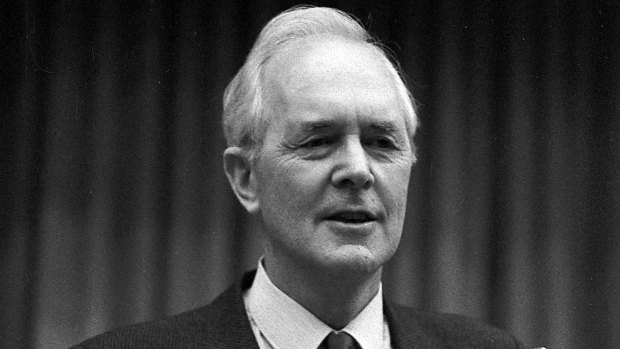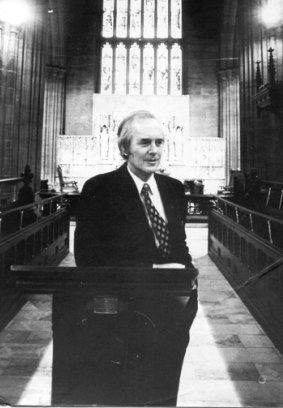This was published 8 years ago
Reserve Bank governor Sir Harold Knight offered distinguished service in war and peace
HARRY KNIGHT 1919-2015
Sir Harold Murray Knight KBE, DSC was an Australian economist, best known as the third governor of the Reserve Bank of Australia, serving from 1975 to 1982.

Sir Harold Knight in 1985.Credit: Steve Holland
Sir Harold, known to his friends and family simply as Harry, rose from humble beginnings to become instrumental in shaping post-war world economies and global finance. Widely acknowledged as having the uncommon ability to excel at almost everything he touched, he is publicly remembered as much for his stellar achievements in central banking, as he is loved by his family and friends for his quiet appreciation of poetry, music and solid family values.
With a flexibility rarely seen among high-level financiers, he was equally adept at mingling with powerful world leaders, as he was fixing and servicing lawnmowers at home. An ex-Navy man and world traveller, he enjoyed the thrill of sailing boats and driving American cars when his taxing schedule allowed.

Sir Harold Knight was equally at home at the pulpit.
Harold Murray Knight was born in Melbourne on August 13, 1919, the son of Walter Knight and his wife, Agnes (nee Hughes), both of solid British working class stock.
Walter was a train driver, and Agnes boosted the family income by buying and selling properties, an influence that may have shaped her son's future investment savvy.
His childhood years during the depression were both difficult and formative. After winning a scholarship to exclusive Scotch College, Melbourne, Knight was forced to leave a year early to help support the family when Walter had to stop work because of poor hearing. The 16-year-old started work as a junior clerk at the Commonwealth Bank, never suspecting that his diligent and reliable work ethic in the public service would open the doors to an epic career in finance.
Five years later, he volunteered for the war effort in World War II, and served in both the army and navy, the latter service on the survey ship, HMAS Polaris. In 1945, he was awarded the Distinguished Service Cross (DSC) for charting and surveying the islands around New Guinea while the region was under Japanese occupation. His maps were used during the war by General Douglas MacArthur, and some are still in use today. In return for his daring maritime service, Knight acquired a life-long love of sailing.
After the armistice, he returned home, but the war years had taken a tragic toll on his family. Not only had both his parents died in quick succession, but his brother Francis had died as a POW on the Burma Railway, while another brother, Gordon, had been run over in a street accident some years before.
Knight suffered his losses with courage, and after returning to work at the Commonwealth Bank in 1946, studied for a degree in commerce at Melbourne University.
His fortunes turned after a series of work promotions led to his transfer to Sydney, where he met his future wife, Gwenyth Pennington, at an Anglican church function.
After their marriage, the couple settled in the suburbs of Sydney and produced five children. Knight applied his considerable handyman skills to renovating and trading property, as an added income to support their growing family.
The Commonwealth Bank continued to reward Knight's skills with a series of rapid promotions, until 1954, when he was seconded to the IMF, an institution tasked with structuring and overseeing the international monetary system. His career in global finance was launched when he was transferred to Washington DC, with his family.
After the Knight family returned to Australia in 1959, he returned to work at the Commonwealth Bank while completing his Master of Commerce degree. The following year, the Reserve Bank separated from the Commonwealth Bank and became a separate entity.
Housed in its own headquarters in Martin Place, the Reserve Bank of Australia (RBA) was now charged with controlling all central banking activities, and Knight, now uniquely qualified for the position, was installed as the head of the Investment Department. From there, he was promoted to deputy governor in 1968, until his appointment as the third governor of the Reserve Bank of Australia, in 1975, an appointment which he held until his retirement in 1982.
His first challenge as RBA governor came during the Whitlam government's dismissal in November, 1975. Under his steady guidance, the central bank weathered both the political turbulence and the manoeuvrings of successive political parties and leaders – including Whitlam, Hayden, Cairns, Crean and Fraser – with exemplary impartiality. His integrity was recognised by Prime Minister Malcolm Fraser, who nominated him for a knighthood and he was duly made Knight Commander of the Order of the British Empire (KBE) for services to banking, in the New Year's Day Honours of 1980.
Of Knight's career at the central bank, current RBA governor Glen Stevens notes: "Sir Harold is remembered for his dedication and integrity, his strong interest in the community and his exemplary leadership."
After his retirement from banking, at 62, Knight found the time for a second career, as director and chairman of notable companies such as Western Mining, ING and Angus & Coote, and as chairman of the Australian board of the Industrial Bank of Japan.
Though his career in central banking featured prominently in his life and demanded much of his time, "it was not what motivated him or gave his life meaning," his son, Dr Andrew Knight, said. His strong, personal Christian faith drove his core values and led him to devote decades of leadership to the Scripture Union, the Crusader Union, the Bible Society and the Anglican Church. He served for many years as a member of the Synod of the Anglican Diocese of Sydney and its Standing Committee, and was a lay canon of St Andrew's Cathedral.
In their 62 years of marriage, the Knights travelled widely, meeting world leaders and dictators alike, including Zhou Enlai, Francisco Franco, Josip Tito and Ferdinand Marcos. Gwenyth died in 2013, then Sir Harold, still in mourning, was struck by a short and fatal illness, just shy of his 96th birthday.
His eldest son, Professor John Knight, recalls in his eulogy: "We say farewell to a lover of Welsh hymns and elderly Mercedes Benzes, sailing boats and minestrone, an eloquent speaker equally at home in the pulpit and in the cabbalistic corridors of economic power, a faithful, loyal husband of 62 years, in the traditional model, a loving father of five, an indulgent grandfather of 15, a tireless builder and handyman, and a man who at one point simultaneously owned and serviced eight different types of lawnmower."
Sir Harold Knight is survived by his children John, Richard, Susan, Andrew and Paul, and their families, including 15 grandchildren and four great-grandchildren.
Eve Kaufman